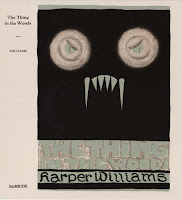It was back in 2000 that Stefan Dziemianowicz revealed here that the 1913 UK-published novel The Thing in the Woods
by Margery Williams was “modestly revised” to be the 1924 US-published
novel of the same title by “Harper Williams.” And since that time I
have wondered just what the differences amount to between the two
editions. So has my friend Russ Bernard, who recently compared the two
versions closely, and with his permission I summarize here what he
discovered. Margery Williams (1881-1944) was a British-writer who
spent much of her early life in Pennsylvania, where she was educated.
Her most famous work was The Velveteen Rabbit (1922). The
pseudonym “Harper Williams” was an amalgam of her mother’s maiden
surname (she was Florence Emily Harper) and her father’s surname (he was
Robert Williams).
The 1913 book has twenty-one chapters; the
1924 version has twenty-two. The chapter titles are pretty much the
same for the first 18 chapters (save for chapter 14, which was first
“The Call in the Night” and was subsequently altered to “The Cry in the
Night”). Chapters 19 through 21 in the 1913 version (“A New Clue”; “The
Thing in the Mill”; and “Conclusion”) are expanded into four chapters in
the 1924 book (“The Mill Dam”; “What We Found in the Saw-Mill”; “The
Thing in the Woods” and “The Silver Bullet”).
In the first
eighteen chapters, the text has been lightly revised, sometimes
replacing British terms (tyre, petrol) with American equivalents (tire,
gasoline). But there are a number of other changes that are stylistic in
nature.
The major changes begin with chapter 19 of the 1913
book. Three chapters have been altered, rewritten, and expanded to
become four chapters in the 1924 edition. According to Russ, the US
version adds some chase scenes to heighten the suspense, and to
establish that the “thing” has unusual strength and endurance. The
“thing” itself is not called a “werewolf” but appears to be intended to
be thought of as one. Russ found the 1913 ending somewhat standard for
the monster books of the period, and while the 1924 version ends
basically in the same way, it makes for a better reading experience for
most readers.

Whew! I'm glad that my 1924 version is the one to have and that I don't have to go looking for the earlier 1913 edition. --md
ReplyDelete